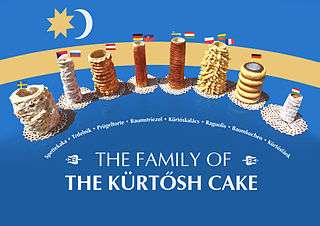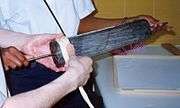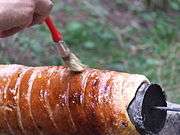Kürtőskalács
 A kürtőskalács decorated with the flags of Székely and Hungary | |
| Place of origin | Covasna and Harghita counties, Burzenland, Romania |
|---|---|
| Main ingredients | flour, sugar, milk, butter, eggs, yeast, salt |
Kürtőskalács (Hungarian pronunciation: [kyrtøːʃkɒlaːtʃ], sometimes transliterated kurtosh kalach) is a spit cake specific to Hungarian-speaking regions in Romania, more predominantly the Székely land. [1] Earlier a festive treat, now it is part of everyday consumption.[2]
Kürtőskalács is made from sweet, yeast dough (raised dough), of which a strip is spun and then wrapped around a truncated cone–shaped baking spit, and rolled in granulated sugar. It is roasted over charcoal while basted with melted butter, until its surface cooks to a golden-brown color. During the baking process the sugar stuck on the kürtőskalács caramelises and forms a shiny, crispy crust. The surface of the cake can then be topped with additional ingredients such as ground walnut or powdered cinnamon.[3]
Etymology
The etymology of the name refers to a stovepipe, since the fresh, steaming cake in the shape of a truncated cone resembles a hot chimney.
This opinion is shared by Attila T. Szabó, scholar and philologist from Kolozsvár, Cluj: "...When cake is taken off from the spit in one piece, it gets the shape of a 25–30-centimetre [9.8–11.8-inch] long vent or tube. Since cake preserves shape when served for both family and guests, consumers are faced with this typical, vent-like image of cake tearing off in strips. It is obvious that "etymology must be closely related to the vent shape of cake".[4]
Throughout the centuries, miscellaneous alternate names and spellings of "kürtőskalács" have been used. More references were mentioned even in the 19th century (e.g. dorongfánk/spit-donut or botratekercs/stick roll-up or botfánk/stick-donut).[5] The name "kürtőskalács" has a Transylvanian origin and became popular only by the middle of the 20th century. Until the end of the century it had different spellings (e.g. spelt with ‘ö’ as in ‘kürtös kalács’ or in two words, as in ‘kürtős kalács’.[6] As far as we know the present name, "kürtőskalács", first appeared in a cookbook, published by the book department of 'Brassói Lapok’ (Transylvanian gazette of the time) in 1926.[7]
The International Kürtőskalács Trade Corporation has taken measures to have kürtőskalács registered as Hungarian product by the European Union.[8]
History
The first known record that hints at a family of cakes baked by rotating spit over cinders dates back to Medieval times (about 1450) and is found in a manuscript from Heidelberg. The description mentions a strip of raised dough that has to be wound in a helix shape around a baking spit, and brushed with egg yolk before baking.[9][10]
In the 16th century, the evolution of the cake family proceeded in three branches. The first branch contains pastries that preserved the image of cake similar to the one mentioned above, with a strip wound on spit in a helical shape. The Szekler-Hungarian kürtőskalács, Skalicky trdelnik (trdelník from Skalica), and the Czech-Moravian trdlo/trdelnice/trdelnik, which is virtually the same as the latter, as well as the kürtősfánk (kürtősh donut) belong to this branch. The second branch has pastries made from batter, namely the Lithuanian raguolis and šakotis, Polish sękacz, the French gateau a la broche, the German Baumkuchen, the Austrian Prügertorte and Prügelkrapfen as well as the Swedish Spettekaka. The third branch is represented by one cake, the Transylvanian-Saxon Baumstriezel, where a continuous dough strip is placed on a spit.[11][12][13][14]


The first known recipe of Kürtőskalács originates from Transylvania, included in the 1784 cookbook of Countess Mária Mikes of Zabola ("‘kürtős kaláts’ à la Mrs. Poráni"). It makes no mention, however, of sweetening of any kind in the preparation.[15][16] A recipe from the cookbook written by Kristóf Simai in 1795 in Upper Hungary (present-day Slovakia) first mentioned "sweetening subsequent to baking".[5] Trdelnik from Szakolca is based on similar preparation, with the cake surface covered in chopped nuts (e.g. walnut, almond) before baking, and sugar that is added only subsequent to baking.[17]

Almost 100 years passed before the first mention was made of the next step in the evolution of kürtőskalács, the appearance of a caramelized sugar glaze, in Aunt Rézi’s Cookbook written by Terézia Dolecskó in 1876, published in Szeged, Hungary.[18] The recipe suggests "sprinkling sugar (sugar almond) on dough on spit a priory to baking". Due to the heat, the sugar is caramelized and also enters in what is known as Maillard reaction.[19] The sugar glaze that melts to become caramel forms a continuous coat, also adds to firmness of cake. Shortly afterwards, pure sugar (not almond sugar) was applied to the dough's surface before baking, even with the omission of sweetening subsequent to baking. Ágnes Zilahi’s cookbook entitled Valódi Magyar szakácskönyv (The Real Hungarian Cookbook), which appeared in Budapest in 1892, presents such a recipe.[20]
The first mention of additional toppings applied to the caramel glaze appears in Rézi néni szakácskönyve (Aunt Rézi’s Cookbook).[18] The use of ground, chopped or candied walnuts applied as an additional topping became popular only in the late 20th century. As far as we know Pál Kövi’s cookbook, Erdélyi lakoma (Transylvanian Feast), which came out in 1980, seems to be the first source with the tip of applying this type of topping.[1] The wide spectrum of cinnamon, coconut, cocoa, etc. toppings started to receive wide application only at the end of the century.
The current, most frequently baked variant of kürtőskalács evolved in Szeklerland in the first half of the 20th century. It is specific to this variant that the surface of the raw dough wrapped around the spit flattens out by the usual procedure of rolling it on a flat surface sprinkled with granulated sugar. By this procedure the layers of dough wrapped around the spit are pressed together, rendering the cake smoother, more compact in structure and more elegant. The first written record of this technique appears in the cookbook of Mrs. Zathureczky, née Manci Zlech, which was published in Barót between 1934 and 1943.[21] The cookbook, entitled Erdélyi ízek (Flavors of Transylvania), which appeared in Csíkszereda (Szeklerburg/Miercurea-Ciuc), published by Proprint Press in 2007, gives a recipe of this sort.[22]
Spread

Kürtőskalács became popular among the Hungarian nobility at the beginning of the 18th century. One hint at an Austrian or German origin is the fact that a conservative Transylvanian nobleman, Péter Apor, in his work Metamorphosis Transylvaniae does not mention Kürtőskalács in the list of traditional Hungarian foods, for all the evidence we have about the cake already existing in his wife's cuisine. In a letter from a mother superior in Moldavia addressed to Mrs Péter Apor, née Borbála Kálnoki, the writer asks Mrs. Apor to have a butler of hers taught the art of baking kürtőslalács: "Honored mother Superior prays you if she could send you a butler in the hope perchance you spare no pain and teach him kindly some art of baking kürtőslalács withal others".[23]

By the end of the 18th century, kürtőskalács had become popular in all Hungarian speaking regions as a defining element of both urban and rustic cuisine. In the first volume of A Székelyöfld leírása (Description of the Szeklerland) from 1868, Balázs Orbán writes about the genesis legend of Udvarhelyszék, which holds that the Szeklers, chased into caves and later blockaded by the Tatars, eventually made the enemy leave by presenting them a huge kürtőskalács made of straw which they held out of the cave to show they had supplies to endure the siege. Throughout the 19th and 20th centuries, the recipe of the cake was recorded in numerous popular cookbooks.[15]
As a result of urbanization at the beginning of the 20th century, kürtőskalács was replaced by newer cakes. But on the eastern periphery of the Hungarian speaking regions, in the Szeklerland, the open fireplace survived to the end of the 19th century, and consequently, kürtőskalács has been preserved as a living tradition on regions dwelt by Szeklers. Up to the present kürtőskalács baked above cinders is regarded as immanent to the Transylvanian wedding menu.[24]

Following the change of regime in 1989, kürtőskalács became the traditional local treat offered to Hungarian tourists visiting Szekler villages and thus an element of the international image of both the Szeklerland and Transylvania. This gastronomic tradition, which earlier had been preserved merely in rural Szekler communities, gradually found its way back to the culture of the Hungarian elite, mainly due to tourism. By the middle of the 1990s, kürtőskalács became popular in most cities in Hungary, and tourists visiting Hungary reported on "the gorgeous, sweet, tubular treat" with admiration.[25] Interethnic relations, as well as the dynamics of power relations between local administrations and the central government of Romania, have seemingly contributed to the spread of kürtőskalács as a popular marker of cultural identity, and possibly to the tendency of crafting and displaying oversized cakes as a cultural signifier of diversity.[26] Because of international migrations and tourism, however, kürtőskalács is also no more regarded as a solely Szekler or Hungarian symbol.[27]
Variants
Three variants of kürtőskalács can be distinguished, which are nonetheless, manufactured in a similar way.[28]
The recipe of the traditional, homemade variant became standardized at the beginning of the 20th century.[6] The ingredients are firmly specified and it is usually baked above cinders. The essential ingredients are exclusively: sugar, wheat flour, butter, milk, eggs, yeast and salt. Additional toppings are restricted to ground or chopped walnut, almond, cinnamon powder or vanilla sugar made from natural vanilla powder.
Variants at carnivals became popular in the late 20th century.[29] With this variant, the recipe is more flexible so that it can be manufactured in smaller, mobile places, rendering it much cheaper. In this variant, butter can be replaced by vegetable oil or margarine, and milk by milk powder. Moreover, eggs can be replaced by egg powder or liquid eggs, but this ingredient can also be omitted. In exchange, grated lemon zest, natural citrus extract or citrus juice, rum or vanilla sugar powder can be added to the dough. The surface can be provided any additional topping that bears flavor and aroma.
Further alternative variants appeared at the beginning of the 21st century. These recipe can be even more flexible. The dough can be made of non–wheat flour. The inner, tubular part can be also given an additional coating, and it can abound in other natural ingredients (e.g. pieces of fruit). Alternative kürtőskalács can be prepared gluten free as well.[25] A cake that lacks ingredients of animal origin (milk, butter, eggs) can be labeled as ‘Vegan’ or ‘Lent’.
Kürtősfánk (Kürtősh Donut) is a similar-shaped cake, which is baked in oil or fat and topped with sugar after baking or stuffed with whipped cream.[11]
Baking process


Kürtőskalács is made of a relatively hard and dry yeast-dough. A "twine" of dough is wrapped around the length of the spit, and then the spit with the strip of dough on it is rolled in sugar. Before or during baking, it's brushed with melted butter. The cake is ready when its surface has an even, brownish–red color. Strictly, homemade kürtőskalács can be made exclusively from natural ingredients (flour, sugar, milk, butter, eggs, yeast and salt). For other variants, of all ingredients it is merely margarine and vanilla sugar powder that can be synthetic, including ingredients of the final topping.

Kürtőskalács can be enriched by further aromas and flavors if the completed cake is provided a final topping. Any topping can be used that does not contain salt, cheese, meat or other non-confectionery ingredients.
Among pastries that are most closely related to kürtőskalács, the Transylvanian Saxon Baumstriezel has a cylinder shape, rather than a helix. Skalicky Trdelnik from Slovakia (formerly Upper Hungary), as well as Trdlo/Trdelnice/Trdelnik from the Czech–Moravian region, differ from kürtőskalács in that there is no caramel sugar glaze applied to their surface.
Foreign names
Neighboring nations have their own names for the cake. Amongst Saxons, who earlier dwelt in Transylvania, the literal translation of the word kürtőskalács, i.e. Schornsteinkuchen, became popular. Poles and Romanians use both the phonetic transcription of the word kürtőskalács and the translation of the adjective – noun cluster of magyar kalács/Hungarian Kalách or székely kalács/Szekler Kalách (Kurtoszkalacz or Wegierski kolacz and respectively Colac Secuiesc or Cozonac Secuiesc). Other languages use either a phonetic transcription of the entire compound word (Kurtosh Kalach), or a phonetic transcription of the cluster’s first element, i.e. ‘kürtős’ – Kurtosh followed by a translation of its second element, 'kalács', "cake".[30]
Similar products around Europe
- Baumstriezel in Austria, Switzerland, and Germany, not to be confused with Baumkuchen
- Gâteau à la broche in France
- Baamkuch in Luxembourg, has become a traditional dish served mostly on special occasions, such as weddings.
- Trdelnik in Czech Republic and Slovakia, a Protected Geographical Indication (PGI) registered by the European Union
- Šakotis in Lithuania (Bamkuchenas as known in western part of Lithuania)
- Sękacz in Poland is a similar cake also cooked on a spit, normally over an open fire.
- Spettekaka in Sweden, a PGI registered by the EU
See also
References
- 1 2 "Kövi Pál, Transylvanian Feast (1980)" (PDF).
- ↑ "kurtoskalacs.lap.hu".
- ↑ "How to prepare?".
- ↑ "Attila Szabó T., Studies on History of Kürtősh Kalách (1968)" (PDF).
- 1 2 "Kristóf Simai's Handwritten Cookbook (1795)" (PDF).
- 1 2 "Historical review of different baking procedures of Kürtősh Kalách" (PDF).
- ↑ "Aunt Biri's Cookbook (1926)" (PDF).
- ↑ "TSG Kürtősh Kalách" (PDF).
- ↑ "Irene KRAUSS, Chronics Bildschöner Backwerke,184 – 195 (1999)" (PDF).
- ↑ "Manuscript from Heidelberg from 1450" (PDF).
- 1 2 "Similar cakes".
- ↑ "Fritz Hahn's Notes on Obelias Bread (1960s)" (PDF).
- ↑ "Fritz Hahn: The Family of 'Baumkuchen' (1964)" (PDF).
- ↑ "Exhibition material of Steiermarkisces Landesmuseum Johanneum Steinz Castle (1979)" (PDF).
- 1 2 "History of Kürtősh Kalách".
- ↑ "Cookbook of Countess Mária Mikes" (PDF).
- ↑ "TSG Trdelnik" (PDF).
- 1 2 "Doleskó Teréz, Cookbook from Szeged (1876)" (PDF).
- ↑ "Molecular Gastronomic Processes" (PDF).
- ↑ "Ágnes Zilahy's Cookbook (1892)" (PDF).
- ↑ "Cookbook of Mrs. Zathureczky, née Manci Zelk(1934-1943)" (PDF).
- ↑ "Flavors of Transylvania (2007)" (PDF).
- ↑ "Letter of Mrs.Bertalan Ferati, née Ágnes Kálnoki (1723)" (PDF).
- ↑ "Lectures by Ferenc Pozsony and Pézter Hantz on Tusványos (2013)" (PDF).
- 1 2 "Application for Kürtősh Kalách Registration" (PDF).
- ↑ "The Longest Pieces of Kürtősh Kalách in the World".
- ↑ "Kürtősh Kalách Baking Tools".
- ↑ "Ingredients and baking of different Kürtősh Kalách variants" (PDF).
- ↑ "Andor Szigeti, Folk Cuisine – From the Tisza and from Beyond (2001)" (PDF).
- ↑ "Tales and Misbelieves around Kürtősh Kalách".
External links
| Wikimedia Commons has media related to Kürtőskalács. |
- Kürtősh Kalach
- Collection of links in Kürtősh Kalách subject
- Baking with an Electric Kurtoskalacs oven
- Delay in saving Hungarian specialty products
- Baking Kürtős Kalách on charcoal operated grilling tool